POLARISED HELIUM : OPENINGS FOR INTERNSHIP AND / OR PhD
2 - Methodological developments for MR imaging at low magnetic field
2023-2024 : Two projects (Master 2 internship and/or PhD) are available for this research topic. This page briefly describes motivations and objectives.
Openings in ³He hyperpolarisation Other openings in the group
Context
Nuclear Magnetic Resonance, NMR, and NMR-based imaging, MRI, usually rely on detection of nuclear magnetic moments from a dense sample (e.g., of hydrogen nuclei in water or tissues) that are passively polarised by an intense magnetic field (1.5 T or higher).
“Hyper”polarised nuclei are increasingly used worldwide for huge sensitivity enhancement in NMR and MRI. Many NMR active nuclei, 1H, 13C, 15N, etc., can be polarised (by DNP) in dedicated molecules. Spin-1/2 noble gas isotopes, 129Xe and 3He, are efficiently polarised by laser optical pumping.
These gases can be used to image the airspaces within the lungs, as currently performed in various research sites.
| COVID-19 damage assessed by 129Xe lung MRI Zhou Lab, Wuhan http://www.zhougroup.org/ https://doi.org/10.1016/j.jechem.2020.05.038 |
 |
| Dec. 2022: XENOVIEW™ (129Xe) approved as hyperpolarised contrast agent for use with MRI for evaluation of lung ventilation in adults and pediatric patients aged 12 years and older. https://xenoview.net/ https://www.129xectc.org/ |
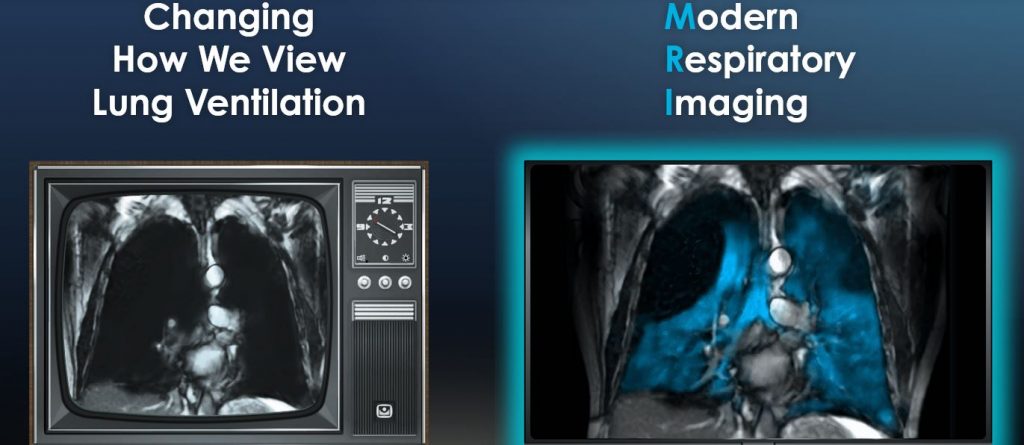 |
Actually, MRI at much lower field strength (in the mT range) may be advantageous for hyperpolarised nuclei. For instance, in lung MRI the local field inhomogeneities resulting from the lung micro-structures and tissue magnetic susceptibility are strongly reduced at low field. This yields much longer lifetimes for transverse magnetisation (i.e., for the NMR signals) and, hence, can allow detection with higher signal-to-noise ratios.
Our group at LKB performs methodological developments and in vitro validation of MRI at low field, with on-site production of hyperpolarised gas, and resorts to collaborations for high-field and/or in vivo tests. We have designed and built a compact MRI system (30 cm in diameter and length) for experiments up to B=5 mT and volumes samples up to 250 cm³. It has been used for initial demonstrations of MRI of polarised ³He gas in glass containers and plastinised excised lungs, as well as for systematic NMR studies of diffusion for a confined gas (restricted diffusion).
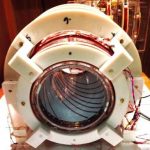 Very low field MRI unit built at LKB (top) and “open” systems used for imaging or diffusion measurements with laser-polarised ³He gas (bottom). Very low field MRI unit built at LKB (top) and “open” systems used for imaging or diffusion measurements with laser-polarised ³He gas (bottom).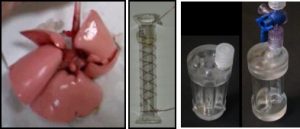 |
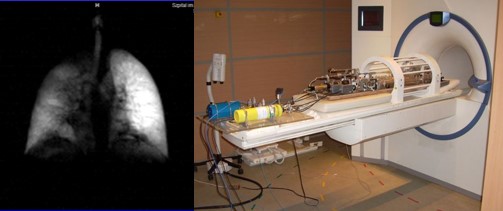 ³He lung image (1.5 T) and in-situ polarisation, Krakow, 2011 |
Our MRI system is now used to develop and test innovative methods in low-field NMR and MRI, both on polarised gas and on water samples, in particular an unconventional MRI technique explored at LKB in collaboration with C. Bidinosti (U. Winnipeg, Canada): TRASE , TRansmit Array Spatial Encoding. TRASE performs imaging via spatial encoding through periodic phase patterns imprinted during rf-driven magnetisation flips (rather than during free precession in static-field gradients).
Our TRASE imaging project
Quiet, inexpensive, and light-weighted gradient-free MRI systems can be made, both at high and low magnetic field, with promising applications for low-cost MRI or MRI in space. There is a need for innovative rf coils and pulse sequences, especially at low field where the response to very short rf pulses was studied in detail.
C.P. Bidinosti, G. Tastevin, and P.-J. Nacher, “Generating accurate tip angles for NMR outside the rotating-wave approximation”, J. Magn. Reson. (2022) 345:107306 <hal-03765938>
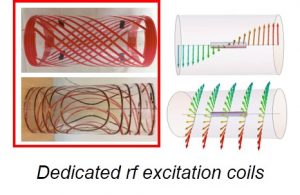 |
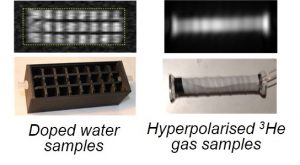 |
Optical detection of NMR (2023-2024)
 Pulses of resonant ac fields are generically used to control the internal state of 2-level systems. The driven travel on the Bloch sphere is a standard (but approximate!) textbook item. Optical monitoring of actual trajectories will provide new insight on recent NMR investigations of deviations due to (often unavoidable) additional components of the oscillating field.
Pulses of resonant ac fields are generically used to control the internal state of 2-level systems. The driven travel on the Bloch sphere is a standard (but approximate!) textbook item. Optical monitoring of actual trajectories will provide new insight on recent NMR investigations of deviations due to (often unavoidable) additional components of the oscillating field.
Please contact us for more information.
The MARGIN project (ANR support, 2019-2024)
Another objective of our group is the use of hyperpolarised ³He gas as a probe for investigation of porous materials. For instance, the MARGIN project (MAgnetic Resonance studies of Gas diffusion In Nanoporous materials) mainly aims at detailed understanding of the influence of gas-wall interactions on NMR diffusion measurements (a pre-requisite for correct interpretation of the results and reliable characterisation of the probed nanoporous systems). Laser-polarised gas is used for room temperature measurements of ³He apparent diffusion coefficients in ordered aerogels, nanopowders, etc… The MARGIN project is also expected to yield data and results in very confined model geometries that might be relevant for different open questions in fundamental physics, such as theoretical description of motion-induced magnetic relaxation and frequency shifts in fluids.
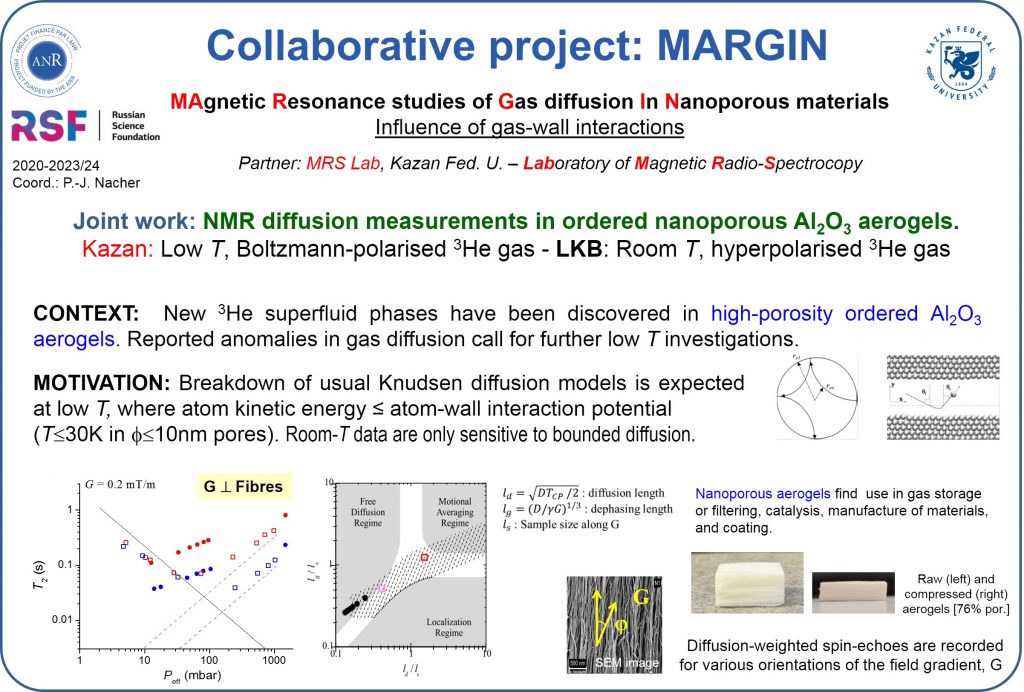 |
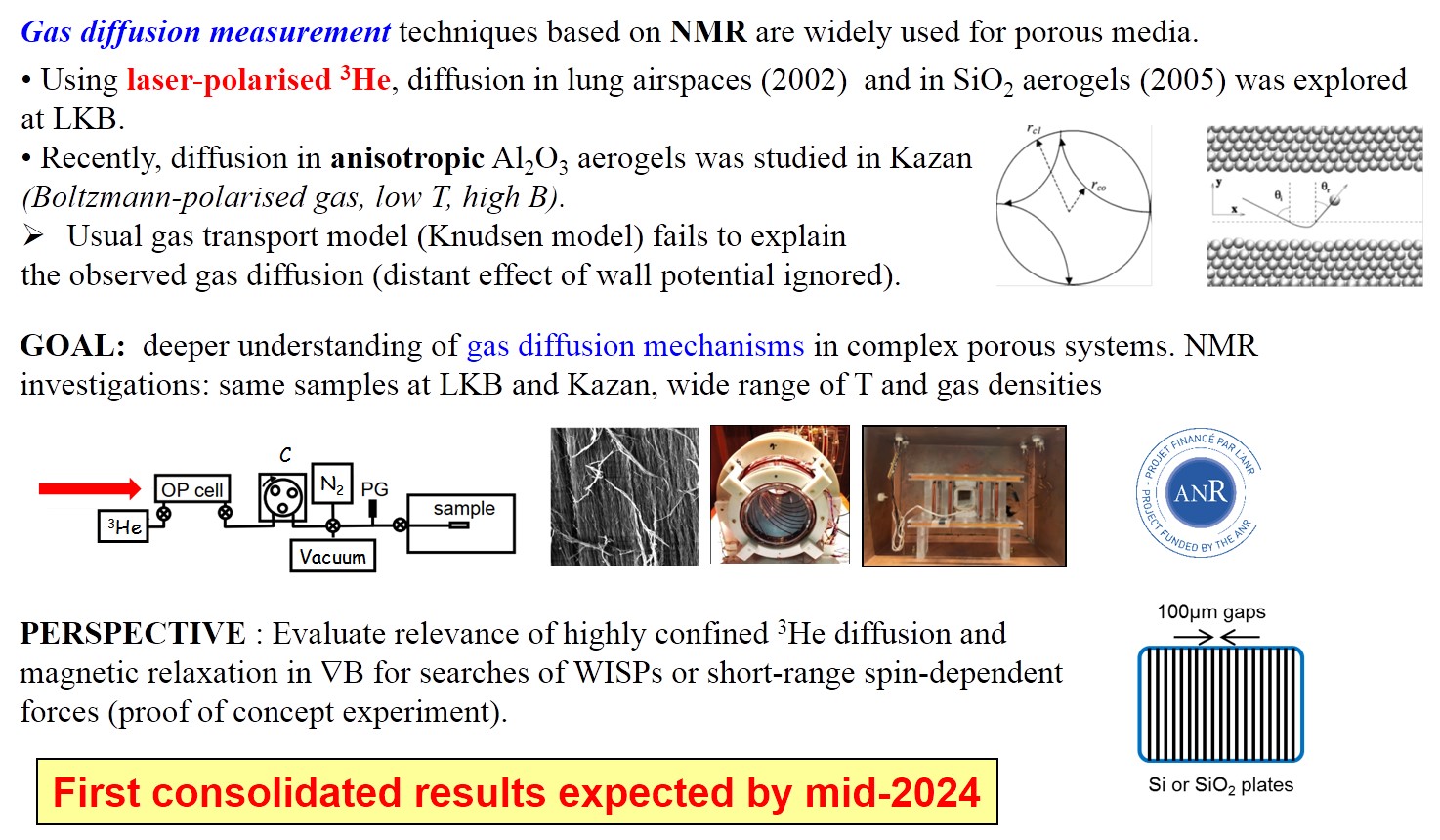 |
The work globally benefits from established collaborations with academic research teams in France, Europe, Russian Federation, and Canada.
NMR studies of restricted gas diffusion (2023-2024)
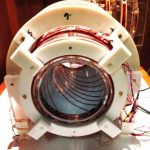 Relying on the team’s experience in low-field NMR and in preparation and use of hyperpolarised ³He gas, new investigations of constrained or restricted gas diffusion within micro- or nano-scale open systems have been launched. The project will focus on anisotropic atom diffusion inside high-porosity ordered Al2O3 aerogels as well as in weakly connected quasi-2D gas slabs.
Relying on the team’s experience in low-field NMR and in preparation and use of hyperpolarised ³He gas, new investigations of constrained or restricted gas diffusion within micro- or nano-scale open systems have been launched. The project will focus on anisotropic atom diffusion inside high-porosity ordered Al2O3 aerogels as well as in weakly connected quasi-2D gas slabs.
Please contact us for more information.
